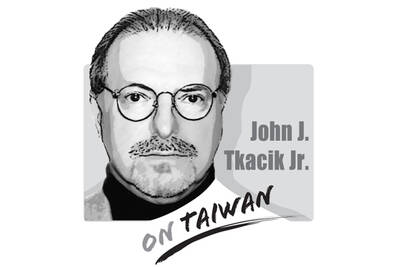Denmark’s recent move to increase the statutory retirement age to 70 for those born after 1970 — the highest in Europe — highlights an obvious and potentially troubling reality: Most of us are facing longer working lives, but that also means we need to remain healthier for longer.
While linking the pensionable threshold to improving longevity is fair, up to a point, doing so risks exacerbating health inequalities, because poor people become sick and die sooner than rich people.
So the focus must be on extending healthy life expectancy for everyone.

Illustration: Mountain People
Closing the gap between lifespans and so-called healthspans can help build public support for later retirement, because fewer years are spent with serious illness or disability, leaving more quality time with grandchildren or on the golf course or at the bingo hall. It can also benefit government finances by reducing pension expenses and costs associated with chronic disease and elderly care, while ensuring workers are able to keep working.
When Otto von Bismarck’s Germany became the first nation to offer old-age social security in 1889, the official retirement age was also 70; but at the time, his compatriots were fortunate if they lived past 45. Today, life expectancy for German men and women is about 78 and 83 respectively, meaning men receive a state pension for about 19 years, while for women it is about 22 years, or about 60 percent longer than in 1980.
The rate at which life expectancy improves has slowed in recent years, and not just because of the COVID-19 pandemic; 65-year-olds now gain nearer one additional year with each passing decade compared with about 1.5 years previously, according to the Organisation for Economic Co-operation and Development (OECD).
Nevertheless, most of us will live longer than our parents and grandparents.
While this is obviously good news, it will put even more pressure on pay-as-you-go social security systems, which face a growing imbalance between the number of retirees and employees. Germany’s statutory retirement age is set to increase to 67 by 2031, but its new government has postponed a politically awkward decision on what happens after that. It should consider indexing the retirement age to longer lifespans, as Denmark does, to help avoid a political row about working longer.
Denmark introduced a quasi-automatic adjustment mechanism in 2006 and variants of this indexation system have been adopted by several European countries.
For Danes, an extra year of life expectancy translates to a full year of additional working time, based on a principle that on average, workers should spend 14.5 years in retirement. This feels harsh when Portugal, Finland and elsewhere apply a two-thirds ratio, meaning employees leave the workforce eight months later for every year of extra life expectancy, thereby preventing a compression of the proportion of life spent in retirement.
In theory, most of us should be able to work longer because in general we are healthier than previous generations were at the same stage in life.
Citing survey data from 41 advanced and emerging economies, the IMF argued in a report in April that, on average, the cognitive abilities of a 70-year-old in 2022 are comparable to those of a 53-year-old in 2000, while in terms of physical frailty a 70-year-old in 2022 is comparable to a 56-year-old two decades ago. So there really is no justification for ageism in the workplace.
However, it is not all good news.
There is evidence, for example, that recent cohorts have a higher prevalence of chronic diseases such as diabetes, and while we are living much longer, many of those years are spent in ill health.
A study published in December last year in JAMA Network Open found that in the past two decades, the gap between healthspans and total lifespan has widened to 9.6 years compared with 8.5 years across 183 WHO members. The US and the UK had two of the largest gaps at 12.4 years and 11.3 years respectively.
Moreover, the affluent and more educated are aging better those from more disadvantaged backgrounds.
In 2022, the Health Foundation think tank found that 60-year-old women in England from the most deprived decile have roughly the same level of diagnosed morbidity as 76-year-old women from the wealthiest decile; meanwhile, men from the most deprived areas die about a decade earlier than the most affluent.
Deteriorating health is a big reason that people exit the workforce early, potentially exposing them to poverty, and raising the statutory retirement age can be regressive because wealthier people end up drawing a pension for longer than poor people.
Furthermore, telling a construction worker to stay on the scaffolding until 70 clearly is not the same as telling an office worker to keep driving a desk. Setting a pension age that accommodates this heterogeneity is not straightforward, although a combination of disability benefits and retraining can help.
Why not index the retirement age to healthspan rather than lifespan, as the longevity author Andrew J. Scott has suggested?
“If we set up a national target for healthy life expectancy we would see much more focus on reducing inequality,” Scott, who is director of economics at the Ellison Institute of Technology in Oxford, told me via e-mail. “We have a health system overly focused on disease which is not the same as keeping people healthy.”
Regrettably, just 1 to 6 percent of OECD member health expenditures go toward health promotion and prevention, according to the IMF.
Public health campaigns to improve diets should be a priority — US Health and Human Services Secretary Robert F. Kennedy Jr’s focus on ultra-processed food is encouraging. And as an advocate for strength training — which slows muscle wastage and improves bone health in elderly people — I think governments should fund public gyms or subsidize access, as Singapore does.
It should not be just a privileged few who live longer, healthier lives. While working longer looks unavoidable for many, how fast we age and how long we spend in ill-health are adaptable, too.
Longer lifespans are great, longer healthspans even better.
Chris Bryant is a Bloomberg Opinion columnist covering industrial companies in Europe. Previously, he was a reporter for the Financial Times. This column reflects the personal views of the author and does not necessarily reflect the opinion of the editorial board or Bloomberg LP and its owners.

On May 7, 1971, Henry Kissinger planned his first, ultra-secret mission to China and pondered whether it would be better to meet his Chinese interlocutors “in Pakistan where the Pakistanis would tape the meeting — or in China where the Chinese would do the taping.” After a flicker of thought, he decided to have the Chinese do all the tape recording, translating and transcribing. Fortuitously, historians have several thousand pages of verbatim texts of Dr. Kissinger’s negotiations with his Chinese counterparts. Paradoxically, behind the scenes, Chinese stenographers prepared verbatim English language typescripts faster than they could translate and type them
More than 30 years ago when I immigrated to the US, applied for citizenship and took the 100-question civics test, the one part of the naturalization process that left the deepest impression on me was one question on the N-400 form, which asked: “Have you ever been a member of, involved in or in any way associated with any communist or totalitarian party anywhere in the world?” Answering “yes” could lead to the rejection of your application. Some people might try their luck and lie, but if exposed, the consequences could be much worse — a person could be fined,
Xiaomi Corp founder Lei Jun (雷軍) on May 22 made a high-profile announcement, giving online viewers a sneak peek at the company’s first 3-nanometer mobile processor — the Xring O1 chip — and saying it is a breakthrough in China’s chip design history. Although Xiaomi might be capable of designing chips, it lacks the ability to manufacture them. No matter how beautifully planned the blueprints are, if they cannot be mass-produced, they are nothing more than drawings on paper. The truth is that China’s chipmaking efforts are still heavily reliant on the free world — particularly on Taiwan Semiconductor Manufacturing
Last week, Nvidia chief executive officer Jensen Huang (黃仁勳) unveiled the location of Nvidia’s new Taipei headquarters and announced plans to build the world’s first large-scale artificial intelligence (AI) supercomputer in Taiwan. In Taipei, Huang’s announcement was welcomed as a milestone for Taiwan’s tech industry. However, beneath the excitement lies a significant question: Can Taiwan’s electricity infrastructure, especially its renewable energy supply, keep up with growing demand from AI chipmaking? Despite its leadership in digital hardware, Taiwan lags behind in renewable energy adoption. Moreover, the electricity grid is already experiencing supply shortages. As Taiwan’s role in AI manufacturing expands, it is critical that